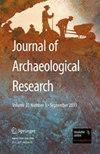Archaeology and Inka Origins
IF 4.1
1区 历史学
Q1 ANTHROPOLOGY
引用次数: 0
Abstract
The recent proliferation of Andean archaeological research presents new interpretive opportunities for reconstructing different aspects of Inka origins. Early colonial historiography reveals that “Inka origins” refers to multiple aspects of the past, including the first appearance of Andean people, Inca ancestors, and the imperial title. The intellectual history of Inka archaeology demonstrates the lasting influence of Spanish colonial interpretive values, even with the gradual introduction of new scientific methods during the 20th century. Since 1970, significant advances in the archaeology of Cuzco, the Inka capital region, and other parts of the Andes have established an independent database that highlights the long-term and regional aspect of Inka origins, as well as areas where interpretive questions remain. The shift from colonial chronicles to archaeological data improves the accuracy of reconstructions of Inka origins, but it also raises some epistemological questions for the future relationships between history and archaeology in the study of ancient empires.考古学与因卡起源
近期安第斯考古研究的激增为重建因卡起源的不同方面提供了新的解释机会。早期的殖民史学显示,"因卡起源 "指的是过去的多个方面,包括安第斯人的首次出现、印加祖先和帝国称号。因卡考古学的思想史表明,即使在 20 世纪逐渐引入新的科学方法的情况下,西班牙殖民时期的解释价值观仍在持续影响着因卡考古学。自 1970 年以来,库斯科、因卡首都地区和安第斯山脉其他地区的考古工作取得了重大进展,建立了一个独立的数据库,突出了因卡起源的长期性和区域性,以及仍存在解释问题的领域。从殖民编年史到考古数据的转变提高了重建因卡人起源的准确性,但也为未来研究古代帝国时历史与考古之间的关系提出了一些认识论问题。
本文章由计算机程序翻译,如有差异,请以英文原文为准。
求助全文
约1分钟内获得全文
求助全文
来源期刊

Journal of Archaeological Research
Multiple-
CiteScore
10.20
自引率
7.90%
发文量
9
期刊介绍:
Journal of Archaeological Research publishes the most recent international research summaries on a broad range of topics and geographical areas. The articles are intended to present the current state-of-the-discipline in regard to a particular geographic area or specific research topic or theme. This authoritative review journal improves access to the growing body of information and literature through the publication of original critical articles, each in a 25-40 page format.2-Year Impact Factor: 4.056 (2017) 5-Year Impact Factor: 4.512 (2017)2 out of 85 on the Anthropology listIncluded in the European Reference Index for the Humanities (ERIH) PLUS The European Reference Index for the Humanities and the Social Sciences (ERIH PLUS) was created and developed by European researchers under the coordination of the Standing Committee for the Humanities (SCH) of the European Science Foundation (ESF). https://dbh.nsd.uib.no/publiseringskanaler/erihplus/about/indexSCImago Journal and Country Rank (SJR) 2018: 1.7102 out of 263 on the Archeology (Arts and Humanities) list3 out of 254 on the Archeology list2 out of 131 on the General Arts and Humanities listSJR is a measure of the journal’s relative impact in its field, based on its number of citations and number of articles per publication year.Source Normalised Impact per Paper (SNIP) 2018: 2.112The SNIP measures contextual citation impact by weighting citations based on the total number of citations in a subject field. The impact of a single citation is given higher value in subject areas where citations are less likely, and vice versa.CiteScore 2018: 3.86Rated ''A'' in the Australian Research Council Humanities and Creative Arts Journal List. For more information, visit: http://www.arc.gov.au/era/journal_list.htm
SCImago Journal and Country Rank (SJR) 2011 1.227 Archeology 1 out of 96 Archeology (Arts and Humanities) 1 out of 59 Arts and Humanities (miscellaneous) 1 out of 243
 求助内容:
求助内容: 应助结果提醒方式:
应助结果提醒方式:


